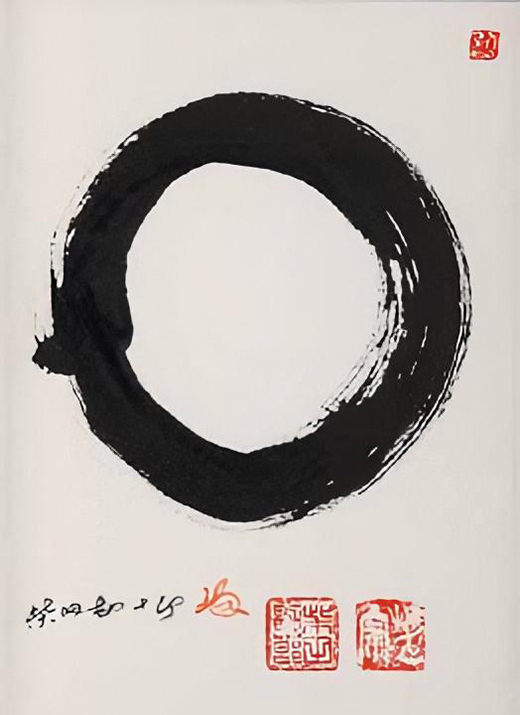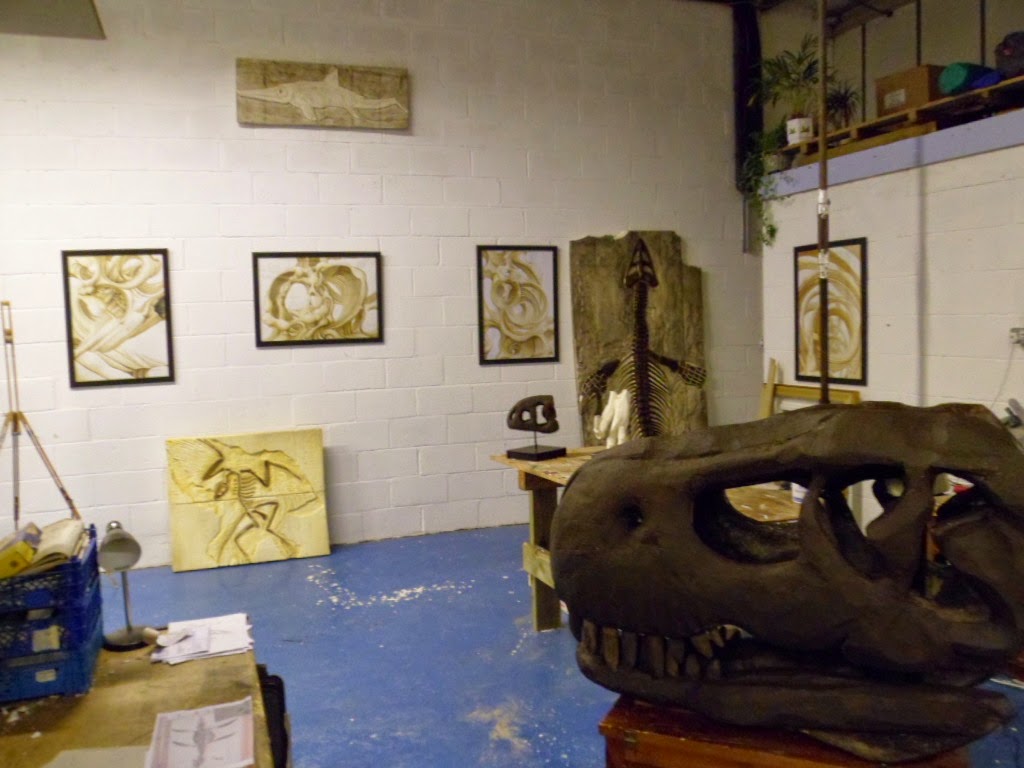
Ensō (c. 2000) by
Kanjuro Shibata XX. Some artists draw
ensō with an opening in the circle, while others close the circle.
In
Zen,
ensō (円相, , "circle") is a circle that is hand-drawn in one or two uninhibited brushstrokes to express a moment when the mind is free to let the body create.
Description[edit]
The
ensō symbolizes absolute
enlightenment, strength, elegance, the universe, and
mu (the void). It is characterised by a
minimalism born of
Japanese aesthetics.
Drawing
ensō is a disciplined-creative practice of Japanese ink painting—
sumi-e (墨絵, "ink painting"). The
tools and mechanics of drawing the
ensō are the same as those used in traditional
Japanese calligraphy: One uses a brush
(筆, fude) to apply ink to
washi (a thin Japanese paper).
The circle may be open or closed. In the former case, the circle is incomplete, allowing for movement and development as well as the perfection of all things. Zen practitioners relate the idea to
wabi-sabi, the beauty of imperfection. When the circle is closed, it represents perfection, akin to Plato's perfect form (
Plato), the reason why the circle was used for centuries in the construction of cosmological models, see
Ptolemy.
Usually, a person draws the
ensō in one fluid, expressive stroke. When drawn according to the
sōsho (草書) style of Japanese calligraphy, the brushstroke is especially swift. Once the
ensō is drawn, one does not change it. It evidences the character of its creator and the context of its creation in a brief, continuous period of time. Drawing
ensō is a
spiritual practice that one might perform as often as once per day.
[1]
This spiritual practice of drawing
ensō or writing Japanese calligraphy for self-realization is called
hitsuzendō (筆禅道, "way of the brush").
Ensō exemplifies the various dimensions of the Japanese
wabi-sabi perspective and aesthetic:
Fukinsei (asymmetry, irregularity),
kanso (simplicity),
koko (basic; weathered),
shizen (without pretense; natural),
yugen (subtly profound grace),
datsuzoku (freedom), and
seijaku (tranquility).
Use outside of Zen Buddhism[edit]
- A variation of the symbol was also used as a logo by Obaku Ltd.. They continue to use an ensō shape as a wristwatch brand.
- Thinking, an international design and consulting house centred in London, uses an ensō[4] meaning "Expression" as one of their four icons, along with icons for science, pattern and vision.
- Philosopher Joseph Campbell's book, The Hero with a Thousand Faces, bears this symbol on its cover representing creativity and uninhibited freedom of expression within art/literature.
- MINDBODY prominently features an ensō in its company logo.
- HSBC bank released a card named zero using as logo an ensō.
- KOAN Sound uses an open ensō in their logo as the 'O' character.
- The Ensō bootloader vulnerability that allows the HENkaku exploit in PlayStation Vita consoles to run permanently uses an ensō as its logo.
See also[edit]
Geometric art
From Wikipedia, the free encyclopedia
(Redirected from Geometric pottery)
Jump to navigation
Jump to search
Geometric art is a phase of
Greek art, characterized largely by geometric
motifs in
vase painting, that flourished towards the end of the
Greek Dark Ages, circa 900 BC – 700 BC. Its center was in
Athens, and from there the style spread among the trading cities of the
Aegean.
[1] The Greek Dark Ages are also called the
Geometric period in reference to this characteristic pottery style, although the historical period is much longer than the art-historical period, being circa 1100 – 800 BC.
[2] The vases had various uses or purposes within Greek society, including, but not limited to, funerary vases and symposium vases.
About the Signature paintings ....
The anima and animus, in Carl Jung's school of analytical psychology, are the two primary anthropomorphic archetypes of the unconscious mind, as opposed to both the theriomorphic and inferior function of the shadow archetypes, as well as the abstract symbol sets that formulate the archetype of the Self. The anima and animus are described by Jung as elements of his theory of the collective unconscious, a domain of the unconscious that transcends the personal psyche. In the unconscious of a man, this archetype finds expression as a feminine inner personality: anima; equivalently, in the unconscious of a woman it is expressed as a masculine inner personality: animus.
The Shadow is a very common archetype that reflects deeper elements of our psyche, where 'latent dispositions' which are common to us all arise. It also reflects something that was once split from us in early management of the objects in our lives. It is, by its name, dark, shadowy, unknown and potentially troubling. It embodies chaos and wildness of character. The shadow thus tends not to obey rules, and in doing so may discover new lands or plunge things into chaos and battle. Shadow may appear in dreams, hallucinations and musings, often as something or someone who is bad, fearsome or despicable in some way. Encounters with it, as an aspect of the subconscious, may reveal deeper thoughts and fears.
Jungians warned that "every personification of the unconscious - the shadow, the anima, the animus, and the Self - has both a light and a dark aspect....the anima and animus have dual aspects: They can bring life-giving development and creativeness to the personality, or they can cause petrification and physical death
''The original premise of the ' signature work ' was really developed at quite a young age ... indeed I have been producing ' the Signature works ' for over 25 years now ... each new body or thread of work, an independent reflection of a parallel thought process ... but very much a component to a much broader body of work ... a lifes work I guess ....
Although I do personally very much ascribe to the notion that anything that has been done by a human hand , can be replicated ... this has been the optimistic philosophy that I have taken into every facet of my work ... and quite often in the tumult of some enormous project or another ... and this is what has now lent that persistent and quite remarkable element to the obviously durable body of work by an artsts that has certainly proven his tenacity and determination to maintain an exceptionally diverse yet accomplished portfolio ...... i was not able to access great reference from the rural and underfunded aspects of the cut off geography that I grew up in - beautiful as it was and does remain ( to a sadly, seemingly ever diminishing degree,) ....pre interenet - pre degree - i was instinctivly working in these mediums from my young teenage years - and it seems will continue to do so
the twenty year plight of being perpetually underfunded or rendered to a state of transcience in a near perpetual state of partially voluntary voluntarism ..... is really begining to start to feel ' the norm ' ''
so buy some freakin art and / or book a class ..... because there is more going on here than the obvious ... and its being done well rather an unusual thing in this day and age x x x































